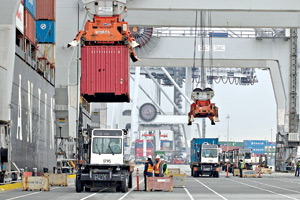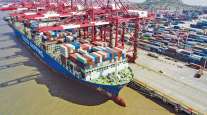Groups Fear New Container Rules Could Create Supply Chain Havoc

Truckers and shipper groups said they fear that a lack of awareness about new mandatory international container weighing rules could create havoc in the supply chain when they take effect July 1.
The rules were put in place through the International Maritime Organization, a United Nations agency that sets international shipping standards. The requirements for weight, known as VGM or “verified gross mass,” are part of a treaty known as Safety of Life at Sea, or SOLAS, negotiated through IMO. The stated purpose was to address concern about overweight shipments that could endanger maritime workers and carriers.
“The problem is getting the word out. Verified gross mass appears to be something of a blind spot in many quarters,” Bruce Carlton, president of the National Industrial Transportation League, told Transport Topics in late December. “Perhaps it’s an indication that a lot of folks just don’t pay much attention to the IMO. In this case, those folks could be really, really disappointed come July 1.”
“We are always concerned that the process and responsibility will be shoved down to us,” adding to ongoing freight delays, said Curtis Whalen, who heads American Trucking Associations’ Intermodal Motor Carriers Conference.
His group’s newsletter is outlining the weight requirement, with advice to drayage carriers to be certain that their customers are aware of the new rules.
One situation Whalen envisions is truckers being stuck with a so-called “trouble ticket” in a port terminal, where delays already are an issue, because the load the driver is supposed to haul lacks the VGM information needed for the shipment to leave the docks.
As a result, Whalen said, truckers would be stuck with the extra time and expense of getting an import shipment weighed whenever there were gaps in the communications process.
He noted that the weighing requirements apply to exports and imports.
The World Shipping Council, a trade group representing ocean carriers, outlined the two acceptable weighing methods and cautioned that its members are being advised not to load any containers without the weight information.
One approach is to weigh the container and its contents after it is packed and sealed. Another method is allowed, Carlton said, where a weighing device isn’t available. It calls for the shipper or a third party to weigh all individual parts of a shipment, such as furniture, and then add in packing material and the container’s empty weight to come up with a VGM.
WSC’s guidance to members noted that the responsibility for certifying the weight falls on the actual shipper of the goods if they give the load directly to the ocean carrier, or on a forwarder if they are managing the shipment.
“Shippers really need to get on with making plans to get this done,” Carlton said.
His group is sending information about the new requirement to manufacturers’ trade groups in Washington, asking them to educate their members.
Whalen said that in addition to using the newsletter he also plans to meet with port management and truckers in the months ahead, starting in Houston during January.
“Frankly,” Whalen said, “this kind of thing shouldn’t be a problem. It’s the last thing anyone needs. But when so many things in the supply chain wind up depending on the trucker, it could become our problem, too.”




